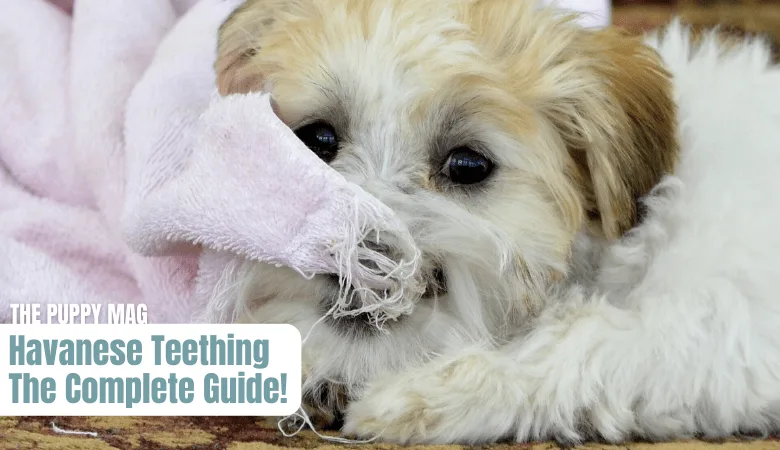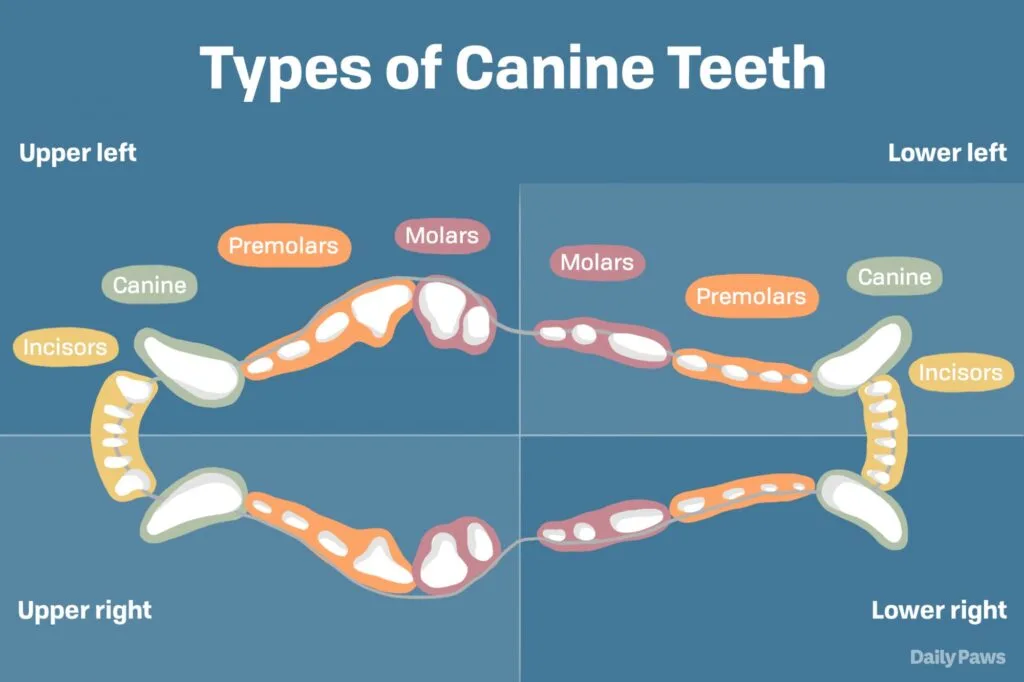It’s not long before owners start asking questions about teething! After you get your Havanese puppy, teething behavior will already be noticeable, so we’ll explain exactly when it starts, ends, how to handle it, and everything in between. This will act as a complete guide answering the most important FAQs on this topic.
Havanese stop teething around 6-8 months of age. In rare cases, it may take a little longer. By 6-8 months your Havanese should have their full set of 42 adult teeth. Although this doesn’t guarantee teething behavior will stop.

When Do Havanese Start Teething?
Havanese start teething from about 3 weeks when their deciduous teeth (baby teeth) start to push through. Right away, the puppy will have an irritable tingly sensation in their gums and have the desire to chew. By 6 weeks, the deciduous teeth should have come through.
What few new owners realize is that by 8 weeks when they pick up their puppy, they will already be teething with brand new (extremely sharp) puppy teeth! And by 12 weeks, the deciduous teeth will start coming out to make way for the adult teeth.
Trending read: Are Havanese Good With Other Dogs
When Do Havanese Stop Teething?
While this is different for all Havanese, the majority will stop teething between 6-8 months of age when their full set of 42 adult teeth are completely through.
In rare cases, it could take up to 10 months, at which point it’s advised to have a check-up with your veterinarian. If your Havanese is late, it doesn’t indicate problems, but it’s always best to play it safe and speak to your veterinarian.
And as I will mention throughout, teething isn’t one big onslaught of pain and destruction… It comes in waves of severity. Sometimes, your puppy won’t chew much and seem very calm, but the following week could be the opposite. Teething is never consistent.

Psst. A quick update on Havanese training! Brain Training For Dogs could be the best training approach we’ve seen for puppies. Results show improvement in obedience and behavior quicker than we thought possible! Check it out.
Havanese Teething Timeline
Let’s break down the significant stages of your Havanese’s teething process. Remember, nothing will be timed exactly.
3 weeks:
Teething begins. At 3 weeks your Havanese still start pushing through 28 deciduous teeth (baby teeth).
6 weeks:
By 6 weeks, all 28 deciduous teeth should have come through and your puppy will be trying to bite and chew everything in sight.
12 weeks:
At 12 weeks, the deciduous teeth start to come out to make way for a brand new set of 42 adult teeth. Usually, the incisors are the first baby teeth to come out.
4 months:
By 16 weeks the baby teeth should be fully out and the adult teeth are well on their way. The adult premolars and canines will likely be pushing through already.
6 months:
At 6 months, the adult molars will likely be showing and should be fully out by 6-7 months of age. More of the smaller teeth will also be pushing through rapidly at this point
8 months:
By 8 months, most Havanese would have completed their teething process. They will have 42 adult teeth in total, 20 in the upper jaw, and 22 in the bottom jaw.
Havanese teeth diagram:
In total, your Havanese will have 12 incisors, 4 large canines, 16 premolars, and 10 molars. This is more or less the same for all breeds.

How Do Havanese Handle Teething & What To Expect
What you’ve heard is true… Teething is a grueling process and it’s something that all puppies and owners have to deal with for the first 8 months.
Your Havanese puppy will experience waves of pain, tingling, itchiness, inflammation, sometimes bleeding, and more… On some days, teething will not be noticeable, and on other days your puppy will experience an intense wave of it (and they will certainly let you know about it!).
Usual reactions to teething:
The inflammation in the gums that happens during teething will cause fluctuating levels of pain and an itchiness sensation that will drive your puppy to chew whatever they can. With all of these new and unpleasant sensations, your puppy’s temperament will be affected negatively. Teething puppies can be very irritable, disobedient, and hard to train.
What about chewing:
Of course, one of the most talked-about aspects of teething is radical chewing behavior. But the truth is, chewing is actually a good thing and will help the overall process. Chewing stimulates the gums and increases blood flow to the area, ultimately speeding up the process of pushing out new teeth. Not to mention, it also provides some level of relief to the itchy sensations the gums produce. (similar to scratching an itchy mosquito bite)
What to expect from your Havanese:
- Increased chewing and biting
- Mood swings and temperament changes
- Irritable and bad behavior
- Lack of attention and focus when training
- Increased drooling
- Appetite changes
- Occassional bleeding (should not be heavy)
Please not on the bleeding, it’s normal to see a little bloody saliva here and there, especially when chewing on toys for a while. But bleeding should not be heavy or consistent. Always use good judgment and be ready to call your vet.
Popular article: Is Coconut Safe For Dogs to Eat?
How To Help Your Havanese With Teething
Let’s run through some of the best tips and tricks that will help your Havanese breeze through teething with minimal pain and destruction.
1. Frozen KONG toy
Opt for a KONG puppy toy (small breed) and you Havanese will have something to take their frustrations out on. KONGs were designed with teething and heavy chewing in mind, plus you can fill the inside with treats/foam/or even peanut butter to keep them occupied for longer.
Make it even more effective by filling the KONG with mashed banana or PB, put it in the freezer for 2 hours. This will freeze the toy and treats inside providing effective relief with the ice-cold temperatures. (it will also make the treats last longer).
Also worth checking out: N-Bone teething treats
2. Rotate toys
To keep your puppy interested in his toys it’s an awesome idea to rotate 2 or 3 different sets of toys. This makes it seem like to your puppy, he’s constantly receiving new toys.
Have 2 or 3 toys down, then after a week, pick them up and replace them with another set. This sounds silly but it actually works great, and will continuously give your puppy something “new” and interesting to chew, rather than your hands or furniture.
3. Frozen rope toy
Rope toys in particular provide a great chewy yet durable texture for your puppy to chomp down on for hours on end. Plus, rope toys freeze well if you wet them beforehand.
The frozen temperature will numb and soothe his inflamed gums providing effective pain relief. While it doesn’t last forever, your puppy will appreciate it. And again, he’ll have something better to chew than your chair leg or slippers!
4. Ice cube treats
Sticking with the frozen theme here! Ice cube treats are easy to make, can help with training, and will calm down an irritated puppy. You can either infuse mashed banana, peanut butter, or weak chicken stock into ice cubes to make some awesome treats.
These are ideal for summer too! Just be sure to give them to your puppy outside or in a place with hard floors. It gets a little messy!
5. Frozen carrots or bananas
Pups can eat both carrots and bananas, just leave them whole and large. Do not give baby carrots or chunks of banana as this poses a choking risk.
Freeze the carrots and bananas whole and they can act as healthy frozen DIY chew for a fraction of the price of shop-bought ones. They will also provide effective and quick pain relief for an irritated puppy.
How To Stop Your Havanese Chewing Things They Shouldn’t
Redirecting your Havanese’s chewing (when it’s wrong) is a crucial part of training your Havanese.
One thing many owners misunderstand is that they wish for their puppy to “stop” chewing altogether. This isn’t the answer. Instead, we have to constantly redirect their inappropriate chewing to appropriate chewing…
Meaning every time your Havanese starts chomping away at your socks, slippers, hands, or furniture, we have to act quickly and positively, using every opportunity as a potential lesson.
We interrupt them with an abrupt “No!” followed by replacing the item with something they are allowed to chew, such as a toy. After their attention remains on the toy for 3-5 seconds, we praise heavily with our voice and treats. That’s essentially it.
This does not work after 1 or 2 tries, neither does it work after 5 or 10. But after 1-3 weeks of constant redirection, your puppy will not be inclined to chew anything that doesn’t get him praise. After all, dogs always want their owner’s approval, and it’s a powerful technique to show your puppy praise and acceptance when chewing only specific items (their toys!).
And lastly, this isn’t just to save your hands or furniture from being destroyed during teething, the lesson is far greater than this and goes way beyond teething. Good habits like this instilled at a young age will set your Havanese up to be obedient for the rest of their life… If you don’t correct your Havanese’s inappropriate chewing, it can quickly form a terrible habit that could last years.
Thanks for reading! Back to more Havanese articles >
Additional reading
- https://vcahospitals.com/know-your-pet/teeth-teething-and-chewing-in-puppies
- https://caringheartsanimalhospital.com/puppy-teething-symptoms/
- https://www.greencrossvets.com.au/services/puppy-teething/
